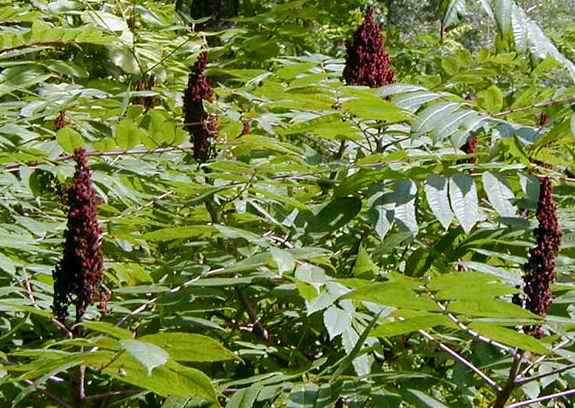|
Common Name: Staghorn Sumac (Sumac is of Semitic origin deriving from the word summaq meaning dark red; Staghorn differentiates this species from the Smooth Sumac, in that the branches have tiny hairs that resemble a stag's antlers) Scientific Name: Rhus typhina, Rhus glabra (Genus Rhus from Greek for red)
Potpourri: Native Americans made extensive use of sumac. The berries were made into a drink to treat fever and the bark was used for sore throats, gum disease and cold sores. Numerous dye colors were derived from sumac: yellow from the stem, orange from the roots, brown from the leaves, and red from the berries. Sumac tannin was used to treat (tan) leather. After the devastation of the Civil War, some Southern entrepreneurs harvested and sold sumac dyes and tannins to replace imported European products.
The berries of the Staghorn and Smooth Sumac appear in characteristic spiked clusters of drupes on the ends of stems in late summer and persist into winter. The tart-sour taste of the drupes is due to a high concentration of malic, citric, fumaric and ascorbic acids. The German name Essigbaum, meaning vinegar tree reflects the unique taste of the berries, which were once made into a drink called Indian lemonade
Sumac is an aggressive shrub that propagates with clones sent out by rootstock which sprout easily and grow rapidly in direct sunlight, choking out other plants. As it is a native plant (smooth sumac is the only shrub native in all 48 contiguous states), it is controlled rather that eliminated. It has been found that cutting back a stand of sumac five times over 2 years will reduce the density by about two thirds.
|
